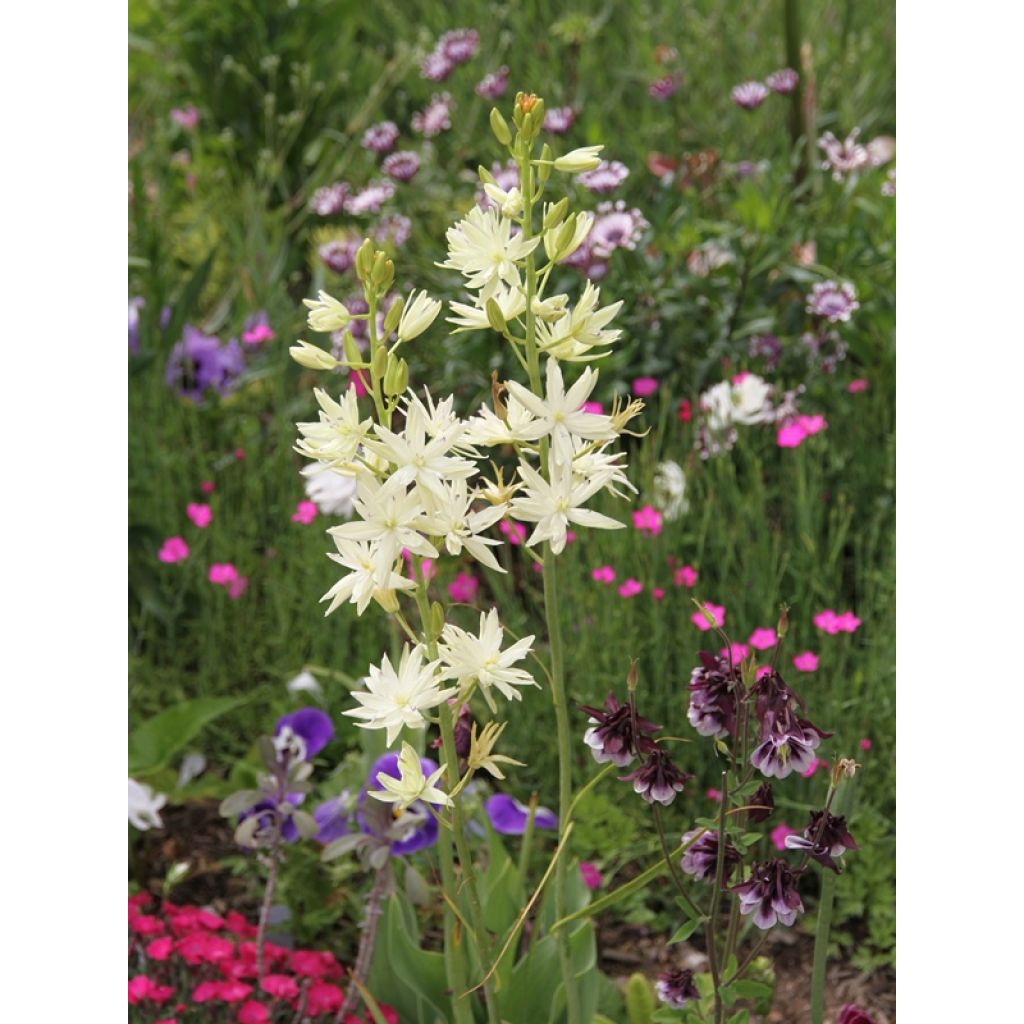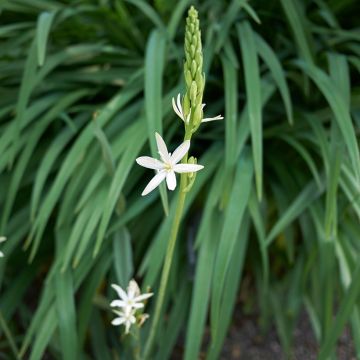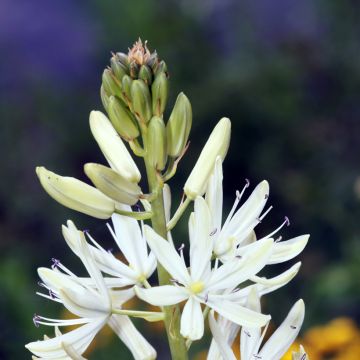

Camassia leichtlinii Semiplena


Camassia leichtlinii Semiplena


Camassia leichtlinii Semiplena
View more pictures
Hide images

Thierry P.

Flowering in May - image 2 - Photo in the rain.
Thierry P. • 84 FR

Thierry P.

Flowering in May - image 3 - Photo in the rain.
Thierry P. • 84 FR

Thierry P.

N/A
Thierry P. • 84 FR
Camassia leichtlinii Semiplena
Camassia leichtlinii Semiplena
Camas
Superb, promise kept. All have left, lovely naked stem. A must-have in one's garden.
Aurore, 26/05/2023
Special offer!
Receive a €20 voucher for any order over €90 (excluding delivery costs, credit notes, and plastic-free options)!
1- Add your favorite plants to your cart.
2- Once you have reached €90, confirm your order (you can even choose the delivery date!).
3- As soon as your order is shipped, you will receive an email containing your voucher code, valid for 3 months (90 days).
Your voucher is unique and can only be used once, for any order with a minimum value of €20, excluding delivery costs.
Can be combined with other current offers, non-divisible and non-refundable.
Why not try an alternative variety in stock?
View all →This plant carries a 6 months recovery warranty
More information
We guarantee the quality of our plants for a full growing cycle, and will replace at our expense any plant that fails to recover under normal climatic and planting conditions.

Would this plant suit my garden?
Set up your Plantfit profile →
Description
Camassia Leichtlinii Semiplena or camas is a perennial bulbous plant with a bushy habit, the most exuberant of the camassias. It flowers from May to June, being the last of the camassias to bloom. However, this flowering is exceptional with spikes of about thirty double star-shaped flowers in cream white. These upright spikes measure from 20 to 50 cm (8 to 20in) long. The inflorescence occurs from the bottom to the top. The flowers, 5 cm (2in) wide, are composed of 6 petals that twist as they fade.
At adulthood, the Camassia measures from 60 to 130 cm (24 to 51in) in height. Its linear leaves are bright green and measure from 20 to 60 cm (8 to 24in) long. They form a tuft from which the floral stems emerge. Native to Oregon in the northwest of the United States, the plant is very hardy. It can be found in flower beds, borders, rockeries, fields, as well as rocky gardens as it is a plant that can grow anywhere. You can cultivate it in a container to place it on a patio or balcony. Camassia flowers are also beautiful in bouquets.
Grow it in the company of later flowering perennials that will hide its withered leaves in summer, such as Japanese peonies. Camassia leichtlinii takes its name from the German Max Leichtlinn. It is a vegetable plant that has an edible bulb, eaten by Native American tribes. These bulbs, however, are not a favourite of rodents, which allows the plant to be among the most resistant bulbous plants, just like daffodils.
Report an error about the product description
Plant habit
Flowering
Foliage
Botanical data
Camassia
leichtlinii
Semiplena
Liliaceae
Camas
Cultivar or hybrid
Planting and care
Place Camassia leichtlinii in partial shade or full sun in a fertile, humus-rich and well-drained soil such as wet meadows. Plant it in autumn at a depth of 10 cm (4in) and space the bulbs 20 cm (8in) apart. Water it regularly but not excessively to avoid plant rot due to stagnant moisture. Camassia naturalises very well when left undisturbed. Mulch in winter in regions with harsh winters. Once the flowers have faded, remove the flower stalks, leaving the stem. Also remove the foliage when it turns yellow. The perennial returns each year with increasing vigour and more abundant inflorescences. Aphids and slugs may attack Camassia, but they cause very little damage as the plant is highly resistant.
Planting period
Intended location
Care
-
, onOrder confirmed
Reply from on Promesse de fleurs
Similar products
Haven't found what you were looking for?
Hardiness is the lowest winter temperature a plant can endure without suffering serious damage or even dying. However, hardiness is affected by location (a sheltered area, such as a patio), protection (winter cover) and soil type (hardiness is improved by well-drained soil).

Photo Sharing Terms & Conditions
In order to encourage gardeners to interact and share their experiences, Promesse de fleurs offers various media enabling content to be uploaded onto its Site - in particular via the ‘Photo sharing’ module.
The User agrees to refrain from:
- Posting any content that is illegal, prejudicial, insulting, racist, inciteful to hatred, revisionist, contrary to public decency, that infringes on privacy or on the privacy rights of third parties, in particular the publicity rights of persons and goods, intellectual property rights, or the right to privacy.
- Submitting content on behalf of a third party;
- Impersonate the identity of a third party and/or publish any personal information about a third party;
In general, the User undertakes to refrain from any unethical behaviour.
All Content (in particular text, comments, files, images, photos, videos, creative works, etc.), which may be subject to property or intellectual property rights, image or other private rights, shall remain the property of the User, subject to the limited rights granted by the terms of the licence granted by Promesse de fleurs as stated below. Users are at liberty to publish or not to publish such Content on the Site, notably via the ‘Photo Sharing’ facility, and accept that this Content shall be made public and freely accessible, notably on the Internet.
Users further acknowledge, undertake to have ,and guarantee that they hold all necessary rights and permissions to publish such material on the Site, in particular with regard to the legislation in force pertaining to any privacy, property, intellectual property, image, or contractual rights, or rights of any other nature. By publishing such Content on the Site, Users acknowledge accepting full liability as publishers of the Content within the meaning of the law, and grant Promesse de fleurs, free of charge, an inclusive, worldwide licence for the said Content for the entire duration of its publication, including all reproduction, representation, up/downloading, displaying, performing, transmission, and storage rights.
Users also grant permission for their name to be linked to the Content and accept that this link may not always be made available.
By engaging in posting material, Users consent to their Content becoming automatically accessible on the Internet, in particular on other sites and/or blogs and/or web pages of the Promesse de fleurs site, including in particular social pages and the Promesse de fleurs catalogue.
Users may secure the removal of entrusted content free of charge by issuing a simple request via our contact form.
The flowering period indicated on our website applies to countries and regions located in USDA zone 8 (France, the United Kingdom, Ireland, the Netherlands, etc.)
It will vary according to where you live:
- In zones 9 to 10 (Italy, Spain, Greece, etc.), flowering will occur about 2 to 4 weeks earlier.
- In zones 6 to 7 (Germany, Poland, Slovenia, and lower mountainous regions), flowering will be delayed by 2 to 3 weeks.
- In zone 5 (Central Europe, Scandinavia), blooming will be delayed by 3 to 5 weeks.
In temperate climates, pruning of spring-flowering shrubs (forsythia, spireas, etc.) should be done just after flowering.
Pruning of summer-flowering shrubs (Indian Lilac, Perovskia, etc.) can be done in winter or spring.
In cold regions as well as with frost-sensitive plants, avoid pruning too early when severe frosts may still occur.
The planting period indicated on our website applies to countries and regions located in USDA zone 8 (France, United Kingdom, Ireland, Netherlands).
It will vary according to where you live:
- In Mediterranean zones (Marseille, Madrid, Milan, etc.), autumn and winter are the best planting periods.
- In continental zones (Strasbourg, Munich, Vienna, etc.), delay planting by 2 to 3 weeks in spring and bring it forward by 2 to 4 weeks in autumn.
- In mountainous regions (the Alps, Pyrenees, Carpathians, etc.), it is best to plant in late spring (May-June) or late summer (August-September).
The harvesting period indicated on our website applies to countries and regions in USDA zone 8 (France, England, Ireland, the Netherlands).
In colder areas (Scandinavia, Poland, Austria...) fruit and vegetable harvests are likely to be delayed by 3-4 weeks.
In warmer areas (Italy, Spain, Greece, etc.), harvesting will probably take place earlier, depending on weather conditions.
The sowing periods indicated on our website apply to countries and regions within USDA Zone 8 (France, UK, Ireland, Netherlands).
In colder areas (Scandinavia, Poland, Austria...), delay any outdoor sowing by 3-4 weeks, or sow under glass.
In warmer climes (Italy, Spain, Greece, etc.), bring outdoor sowing forward by a few weeks.












































